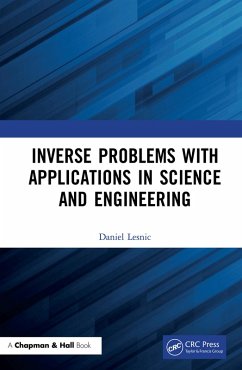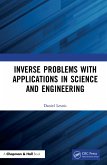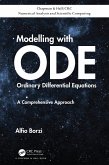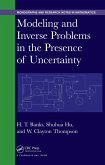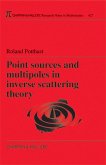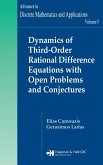Inverse Problems with Applications in Science and Engineering (eBook, ePUB)


Alle Infos zum eBook verschenken

Inverse Problems with Applications in Science and Engineering (eBook, ePUB)
- Format: ePub
- Merkliste
- Auf die Merkliste
- Bewerten Bewerten
- Teilen
- Produkt teilen
- Produkterinnerung
- Produkterinnerung

Hier können Sie sich einloggen

Bitte loggen Sie sich zunächst in Ihr Kundenkonto ein oder registrieren Sie sich bei bücher.de, um das eBook-Abo tolino select nutzen zu können.
Driven by the advancement of industrial mathematics and the need for impact case studies, Inverse Problems with Applications in Science and Engineering thoroughly examines the state-of-the-art of some representative classes of inverse and ill-posed problems for partial differential equations (PDEs). The natural practical applications of this examination arise in heat transfer, electrostatics, porous media, acoustics, fluid and solid mechanics - all of which are addressed in this text.
Features:
Covers all types of PDEs - namely, elliptic (Laplace's, Helmholtz, modified Helmholtz,…mehr
- Geräte: eReader
- mit Kopierschutz
- eBook Hilfe
![Inverse Problems with Applications in Science and Engineering (eBook, PDF) Inverse Problems with Applications in Science and Engineering (eBook, PDF)]() Daniel LesnicInverse Problems with Applications in Science and Engineering (eBook, PDF)46,95 €
Daniel LesnicInverse Problems with Applications in Science and Engineering (eBook, PDF)46,95 €![Modelling with Ordinary Differential Equations (eBook, ePUB) Modelling with Ordinary Differential Equations (eBook, ePUB)]() Alfio BorzìModelling with Ordinary Differential Equations (eBook, ePUB)48,95 €
Alfio BorzìModelling with Ordinary Differential Equations (eBook, ePUB)48,95 €![Inverse Boundary Spectral Problems (eBook, ePUB) Inverse Boundary Spectral Problems (eBook, ePUB)]() Alexander KachalovInverse Boundary Spectral Problems (eBook, ePUB)63,95 €
Alexander KachalovInverse Boundary Spectral Problems (eBook, ePUB)63,95 €![Modeling and Inverse Problems in the Presence of Uncertainty (eBook, ePUB) Modeling and Inverse Problems in the Presence of Uncertainty (eBook, ePUB)]() H. T. BanksModeling and Inverse Problems in the Presence of Uncertainty (eBook, ePUB)63,95 €
H. T. BanksModeling and Inverse Problems in the Presence of Uncertainty (eBook, ePUB)63,95 €![Point Sources and Multipoles in Inverse Scattering Theory (eBook, ePUB) Point Sources and Multipoles in Inverse Scattering Theory (eBook, ePUB)]() Roland PotthastPoint Sources and Multipoles in Inverse Scattering Theory (eBook, ePUB)157,95 €
Roland PotthastPoint Sources and Multipoles in Inverse Scattering Theory (eBook, ePUB)157,95 €![Dynamics of Third-Order Rational Difference Equations with Open Problems and Conjectures (eBook, ePUB) Dynamics of Third-Order Rational Difference Equations with Open Problems and Conjectures (eBook, ePUB)]() Elias CamouzisDynamics of Third-Order Rational Difference Equations with Open Problems and Conjectures (eBook, ePUB)63,95 €
Elias CamouzisDynamics of Third-Order Rational Difference Equations with Open Problems and Conjectures (eBook, ePUB)63,95 €![Applications of Differential Transform to Real World Problems (eBook, ePUB) Applications of Differential Transform to Real World Problems (eBook, ePUB)]() Yogeshwari F PatelApplications of Differential Transform to Real World Problems (eBook, ePUB)186,95 €
Yogeshwari F PatelApplications of Differential Transform to Real World Problems (eBook, ePUB)186,95 €-
-
-
Features:
- Covers all types of PDEs - namely, elliptic (Laplace's, Helmholtz, modified Helmholtz, biharmonic and Stokes), parabolic (heat, convection, reaction and diffusion) and hyperbolic (wave)
- Excellent reference for post-graduates and researchers in mathematics, engineering and any other scientific discipline that deals with inverse problems
- Contains both theory and numerical algorithms for solving all types of inverse and ill-posed problems
Dieser Download kann aus rechtlichen Gründen nur mit Rechnungsadresse in A, B, BG, CY, CZ, D, DK, EW, E, FIN, F, GR, HR, H, IRL, I, LT, L, LR, M, NL, PL, P, R, S, SLO, SK ausgeliefert werden.
- Produktdetails
- Verlag: Taylor & Francis eBooks
- Seitenzahl: 358
- Erscheinungstermin: 9. November 2021
- Englisch
- ISBN-13: 9780429683244
- Artikelnr.: 62613158
- Verlag: Taylor & Francis eBooks
- Seitenzahl: 358
- Erscheinungstermin: 9. November 2021
- Englisch
- ISBN-13: 9780429683244
- Artikelnr.: 62613158
- Herstellerkennzeichnung Die Herstellerinformationen sind derzeit nicht verfügbar.
linear algebraic equations. 1.3. Regularization methods. 2. Inverse
boundary-value problems. 2.1 Cauchy problem for the Laplace equation. 2.2.
Cauchy problem for the Stokes system. 2.3. Cauchy-type problems for the
biharmonic equation. 2.4. Cauchy problems for the heat equation. 2.5.
Conclusions. 3. Inverse initial-value problems. 3.1. Quasi-reversibility
methods. 3.2. Logarithmic convexity methods. 3.3. Non-local initial-value
methods. 4. Space-dependent heat sources. 4.1. Space-dependent heat source
identification. 4.2. Simultaneous identification of the space-dependent
heat source and initial temperature. 5. Time-dependent heat sources. 5.1.
Time-dependent heat source identification. 5.2. Non-local variants. 6.
Space- and time-dependent sources. 6.1. Additive space- and time-dependent
heat sources. 6.2. Additive space- and time-dependent heat sources.
Integral observations. 6.3. Multiplicative space- and time-dependent
source. 7. Inverse wave force problems. 7.1. Determination of a
space-dependent force in the one-dimensional wave equation from Cauchy
data. 7.2. Determination of the force function in the multi-dimensional
wave equation from Cauchy data. 7.3. Determination of a space-dependent
force function from final or time-averaged displacement data. 8.
Reconstruction of interfacial coefficients. 8.1. Introduction. 8.2.
Mathematical formulation. 8.3. Conjugate gradient method (CGM). 8.4.
Numerical results and discussions. 9. Identification of constant parameters
in diffusion. 9.1. Homogeneous and isotropic diffusion. 9.2. A
two-dimensional tracer dispersion problem. 9.3. Determination of constant
thermal properties. 10. Time-dependent conductivity. 10.1. Identification
of the time-dependent conductivity. 10.2. Identification of the
time-dependent conductivity of an inhomogeneous diffusive material. 10.3.
Finding the time-dependent diffusion coefficient from an integral
observation. 11. Space-dependent conductivity. 11.1. Reconstruction of a
permeability function from core measurements and pressure data. 11.2.
Discontinuous anisotropic conductivity. 11.3. Reconstruction of an
orthotropic conductivity. 12. Nonlinear conductivity. 12.1. Determination
of nonlinear thermal properties. 12.2. Nonlinear and heterogeneous
conductivity. 13. Anti-reflection coatings. 13.1. Mathematical model and
analysis. 13.2. Numerical implementation. 13.3. Conclusions. 14. Flexural
rigidity of a beam. 14.1. Distributed parameters in beam-type systems.
14.2. The comparison model method. 14.3. Determination of the flexural
rigidity of a beam from limited boundary measurements.
linear algebraic equations. 1.3. Regularization methods. 2. Inverse
boundary-value problems. 2.1 Cauchy problem for the Laplace equation. 2.2.
Cauchy problem for the Stokes system. 2.3. Cauchy-type problems for the
biharmonic equation. 2.4. Cauchy problems for the heat equation. 2.5.
Conclusions. 3. Inverse initial-value problems. 3.1. Quasi-reversibility
methods. 3.2. Logarithmic convexity methods. 3.3. Non-local initial-value
methods. 4. Space-dependent heat sources. 4.1. Space-dependent heat source
identification. 4.2. Simultaneous identification of the space-dependent
heat source and initial temperature. 5. Time-dependent heat sources. 5.1.
Time-dependent heat source identification. 5.2. Non-local variants. 6.
Space- and time-dependent sources. 6.1. Additive space- and time-dependent
heat sources. 6.2. Additive space- and time-dependent heat sources.
Integral observations. 6.3. Multiplicative space- and time-dependent
source. 7. Inverse wave force problems. 7.1. Determination of a
space-dependent force in the one-dimensional wave equation from Cauchy
data. 7.2. Determination of the force function in the multi-dimensional
wave equation from Cauchy data. 7.3. Determination of a space-dependent
force function from final or time-averaged displacement data. 8.
Reconstruction of interfacial coefficients. 8.1. Introduction. 8.2.
Mathematical formulation. 8.3. Conjugate gradient method (CGM). 8.4.
Numerical results and discussions. 9. Identification of constant parameters
in diffusion. 9.1. Homogeneous and isotropic diffusion. 9.2. A
two-dimensional tracer dispersion problem. 9.3. Determination of constant
thermal properties. 10. Time-dependent conductivity. 10.1. Identification
of the time-dependent conductivity. 10.2. Identification of the
time-dependent conductivity of an inhomogeneous diffusive material. 10.3.
Finding the time-dependent diffusion coefficient from an integral
observation. 11. Space-dependent conductivity. 11.1. Reconstruction of a
permeability function from core measurements and pressure data. 11.2.
Discontinuous anisotropic conductivity. 11.3. Reconstruction of an
orthotropic conductivity. 12. Nonlinear conductivity. 12.1. Determination
of nonlinear thermal properties. 12.2. Nonlinear and heterogeneous
conductivity. 13. Anti-reflection coatings. 13.1. Mathematical model and
analysis. 13.2. Numerical implementation. 13.3. Conclusions. 14. Flexural
rigidity of a beam. 14.1. Distributed parameters in beam-type systems.
14.2. The comparison model method. 14.3. Determination of the flexural
rigidity of a beam from limited boundary measurements.
- Helcio R. B. Orlande, Federal University of Rio de Janeiro
